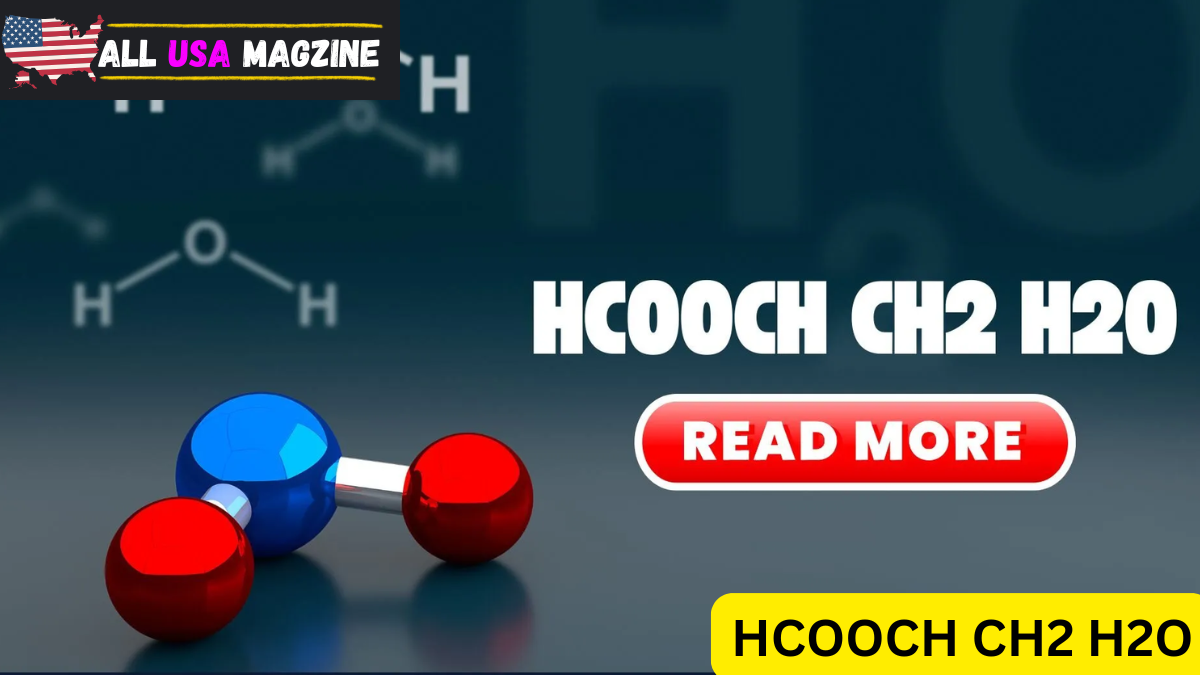The world of organic chemistry is full of fascinating molecules that exhibit unique properties and behaviors. Among these molecules, HCOOCH CH2 H2O represents a combination of functional groups and chemical structures that has practical applications in various fields. This chemical formula is a combination of formate ester, methylene group, and water, all of which can play essential roles in different chemical reactions and processes. In this article, we will explore the significance of this molecule and the relationships between its components.
Decoding the Chemical Formula
To fully understand HCOOCH CH2 H2O, it’s crucial to break down the formula into its constituent parts. The molecule contains several recognizable components that belong to different families of organic compounds.
First, we have HCOO, which represents a HCOOCH CH2 H2O formate group. Formates are the salts or esters of formic acid, a simple carboxylic acid (HCOOH). In this structure, the formate group is bonded to the rest of the molecule, signifying it is part of an ester linkage.
The second part of the formula is OCH, which can be interpreted as a methylene group (-CH2-) bonded to an oxygen atom. This suggests that the molecule contains an ether linkage between a formate group and a methylene group. The methylene group is a versatile building block in organic chemistry, serving as a bridge between various functional groups.
Finally, the formula includes H2O, which represents water, a molecule that is involved in numerous chemical reactions, especially in hydration or hydrolysis processes.
Understanding this structure, we can now consider the behavior of the molecule and how it may be involved in chemical reactions or in various industrial and environmental contexts.
Chemical Behavior and Reactions
The HCOOCH CH2 H2O molecule, as suggested by its structure, can participate in different types of reactions. It is crucial to recognize how the functional groups (formate, methylene, and water) influence the molecule’s reactivity.
Ester Hydrolysis
One of the significant reactions this molecule can undergo is ester hydrolysis. Ester hydrolysis is a reaction where the ester (formate group in this case) reacts with water (H2O) to break down the ester bond. This type of reaction is catalyzed by either an acid or a base and results in the formation of the corresponding alcohol and acid. In the case of HCOOCH CH2 H2O, the ester bond between the formate group and the methylene group can be hydrolyzed to produce formic acid and methanol. This reaction is often essential in both industrial processes and biological systems, where enzymes like esterases facilitate the breakdown of esters.
Role in Organic Synthesis
The ester functional group in HCOOCH CH2 H2O also opens up possibilities for use in organic synthesis. Esters are often employed in the creation of more complex molecules, including fragrances, plastics, and pharmaceuticals. The methylene group (-CH2-) is another valuable component in organic synthesis as it can serve as a linker or spacer in the construction of larger molecules. The combination of the formate ester and methylene group in this molecule makes it useful for synthesizing a wide range of organic compounds, from simpler molecules to more complex polymers.
Solvent and Reaction Medium
Water, as present in this structure, is also a crucial solvent in many chemical reactions. In organic chemistry, water can serve as a medium for hydrolysis reactions, as already mentioned, or even as a reactant. This molecule, containing water, could indicate its role in reactions that involve the solvation of ions or the exchange of hydrogen and hydroxyl ions. Water’s high dielectric constant and ability to stabilize charged species make it an ideal solvent in many aqueous-based reactions.
Applications in Industry and Research
The molecule HCOOCH CH2 H2O, although not one of the most commonly encountered compounds, still has practical relevance in various fields, especially in industries like pharmaceuticals, agriculture, and environmental science.
Pharmaceutical Industry
In the pharmaceutical industry, ester compounds are frequently used as intermediates in drug development. Esters can influence the solubility, stability, and absorption of drugs, making them crucial in the design of therapeutic agents. The presence of the methylene group in this molecule could help researchers in synthesizing new drug compounds with desired properties. Additionally, ester hydrolysis plays an important role in the breakdown of drugs in the body, making an understanding of these processes essential in drug design and pharmacokinetics.
Agriculture and Pesticides
In agriculture, esters and related molecules are widely used as pesticides and herbicides. The formate group, specifically, is often found in the structure of certain insecticides and fungicides. The ability of HCOOCH CH2 H2O to undergo hydrolysis reactions makes it relevant in the study of how pesticides degrade in the environment. Understanding its breakdown can help improve the safety and efficacy of agricultural chemicals, ensuring they perform their tasks without leaving harmful residues in the environment.
Environmental Science
The degradation of organic compounds like esters and alcohols in water bodies is a significant area of research in environmental science. Molecules like HCOOCH CH2 H2O, which can break down in aqueous environments, could be studied for their impact on aquatic ecosystems. The process of ester hydrolysis, when accelerated by environmental factors like temperature and microbial activity, can influence the persistence of certain organic pollutants in water systems. As such, understanding the stability and degradation rates of such compounds is important for environmental management and pollution control.
Conclusion
The molecular structure represented by HCOOCH CH2 H2O is a fascinating example of the interactions between functional groups like esters, methylene groups, and water. Its ability to undergo hydrolysis reactions, its role in organic synthesis, and its potential applications in fields such as pharmaceuticals, agriculture, and environmental science make it a compound of significant interest in both academic and industrial research.













